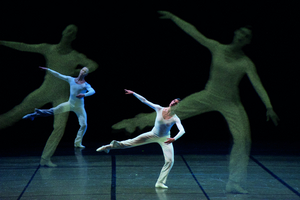Review: DANCE, Sadler's Wells
A mini-masterpiece as minimalist and abstract as its name.

![]() Philip Glass is arguably the most divisive composer of the last century. His music has been compared to the sound of a skipping CD or the aural equivalent of "boiling the frog".
Philip Glass is arguably the most divisive composer of the last century. His music has been compared to the sound of a skipping CD or the aural equivalent of "boiling the frog".
Even his fans would agree that his minimalist approach of layering melodies one on top of the other in an abstract fashion is an acquired taste. He has described his own work as "music with repetitive structures", and in this new interpretation of Dance, which he co-created with choreographer Lucinda Childs, we see the very essence of his style expressed in physical form.
Before creating Dance (probably the most Glass name for any Glass-related work) in 1979, the two worked together on the epic Einstein On The Beach - which, on the face of it, is a daunting experience, being a five-hour long opera that does not tell a story, preferring to let the audience decide their own interpretation. To those unfamiliar with Glass's work, the much shorter Dance, revived here by Lyon Opera Ballet as part of the Van Cleef & Arpels-sponsored Dance Reflections season, may come across as baffling or monotonous (at least one couple left midway through the show on press night).
But Childs does a superb job of marrying movement to music, creating choreography which is built on seeing the same motions replayed over and over with slight additions each time. Employing standard ballet techniques like glissades, sauts and pirouettes, basic moves become skilfully executed and complex manoeuvres which build up gradually to an energetic crescendo.
Spread over three acts, each becoming that bit more demonstrative than the last, the 17-strong crew are seen behind a transparent projection screen the height and width of the stage. Upon it, we are shown a remake of the Sol Lewitt film which accompanied the original displaying a recording of the Lyon Opera Ballet dancers going through the same motions in a studio as they are simultaneously performing live behind the screen.
This has a dual purpose. On the one hand, the projection screen is a nod to the artistic mores of the Seventies by creating a "flat" Warholian representation, a two-dimensional view of the three-dimensional performance. On the other, the different angles seen in the film allow us to explore and examine the intricacy in Childs' choreography from two perspectives.
The aesthetics deliver a vision heavy on abstraction and layering. The dancers are dressed by A. Christina Giannini from head to toe in the same monochromatic outfit - white top, white trousers and white flats - and move across a stage with a black background. Adding to that vivid contrast, dancers suddenly appear from (or disappear behind) barely visible black curtains.
At an hour long, Dance does not overstay its welcome and, with its three separate acts, is an action-packed show by the American composer's standards. The visual abstractions become heavy-handed, unrewarding and obvious towards the end but there's no denying the power of the overall effect.
For fans of his "repetitive structures", this is essential viewing: the intense combination of music and movement is the epitome of Glass and a true pleasure for the eyes and the ears. Those new to his oeuvre can decide whether to fall under the spell of the hypnotic music or be slowly moved upward into a state of heavenly exultation. Dance is not an easy work for Glass novices, but when was anything worthwhile easy?
Dance returns for its second and final performance tonight at Sadler's Wells
Reader Reviews

Videos
.png)